AIX290 Essay: Economic Inequality Rise in Australia Since 1970s
VerifiedAdded on 2023/04/24
|10
|2603
|485
Essay
AI Summary
This essay investigates the significant increase in economic inequality in Australia since the 1970s, exploring various contributing factors. It delves into the complexities of wealth inequality, highlighting the disparity in wealth distribution among different segments of the population. The analysis further examines the influence of skill-biased technical changes, where technological advancements favor skilled workers, leading to wage disparities. The essay also assesses the impact of tax and welfare regimes, and how changes in these policies have affected income distribution. Finally, it considers the role of economic crises, such as the 1974-75 and the 1990-92 recessions, and the 2008 GFC, in exacerbating economic inequality. The author uses Gini coefficient to measure the inequality. The essay concludes with a call for government intervention, including policies to manage unemployment, improve social security, and address wage disparities to foster a more equitable economic environment.

Australia today
2 / 1 4 / 2 0 1 9
2 / 1 4 / 2 0 1 9
Paraphrase This Document
Need a fresh take? Get an instant paraphrase of this document with our AI Paraphraser

Australia today 1
Why has economic inequality increased in Australia since the 1970s?
Australians likes to think as an egalitarian, and in the past, Australian believed that they had an
equal distribution of income as well as wealth. Since the year 1970, individuals have been
dealing with the issue linked to the conservative understanding that has associated to the shortage
aspect instead of attaining positive way of handling wealth. Economic inequality is a wide topic
of economics that majorly focus on the distribution of wealth in the country. This paper focuses
on the reason, which leads to the rise in the economic inequality in Australia since the year
1970s. In most of the OECD, the income inequality level has been increased in past 20-30 years
and Australia is one of the countries who have registered the growth in the economic inequality
(Whiteford, 2013). This argument is supported with the different reasons, which include
deliberate policy, a shift in the income from wages to profit, and many others. Thus, this has
been found that there are different real problems that are essential to be addressed.
The economic inequality in Australia is difficult to be measured as it remains complex for the
long run but the measurement of the inequality is required by the country so that they can
analyse the economic situation of the country. This has been found that Gini coefficient is
majorly used with the motive to measure the inequality that varies between zero and one. This
has been found that if everyone in the country has exactly the similar income then it would be
approx. zero, which is faultless equality. However, on the other side, suppose in case, one of the
household had all the income then it will get equal to one that reflects the complete inequality.
According to the current statistics for the OECD countries, from the year 2010, it is clear that the
country is considered as 11th utmost unsatisfactory of 34 members of OECD (Whiteford, 2014).
Why has economic inequality increased in Australia since the 1970s?
Australians likes to think as an egalitarian, and in the past, Australian believed that they had an
equal distribution of income as well as wealth. Since the year 1970, individuals have been
dealing with the issue linked to the conservative understanding that has associated to the shortage
aspect instead of attaining positive way of handling wealth. Economic inequality is a wide topic
of economics that majorly focus on the distribution of wealth in the country. This paper focuses
on the reason, which leads to the rise in the economic inequality in Australia since the year
1970s. In most of the OECD, the income inequality level has been increased in past 20-30 years
and Australia is one of the countries who have registered the growth in the economic inequality
(Whiteford, 2013). This argument is supported with the different reasons, which include
deliberate policy, a shift in the income from wages to profit, and many others. Thus, this has
been found that there are different real problems that are essential to be addressed.
The economic inequality in Australia is difficult to be measured as it remains complex for the
long run but the measurement of the inequality is required by the country so that they can
analyse the economic situation of the country. This has been found that Gini coefficient is
majorly used with the motive to measure the inequality that varies between zero and one. This
has been found that if everyone in the country has exactly the similar income then it would be
approx. zero, which is faultless equality. However, on the other side, suppose in case, one of the
household had all the income then it will get equal to one that reflects the complete inequality.
According to the current statistics for the OECD countries, from the year 2010, it is clear that the
country is considered as 11th utmost unsatisfactory of 34 members of OECD (Whiteford, 2014).
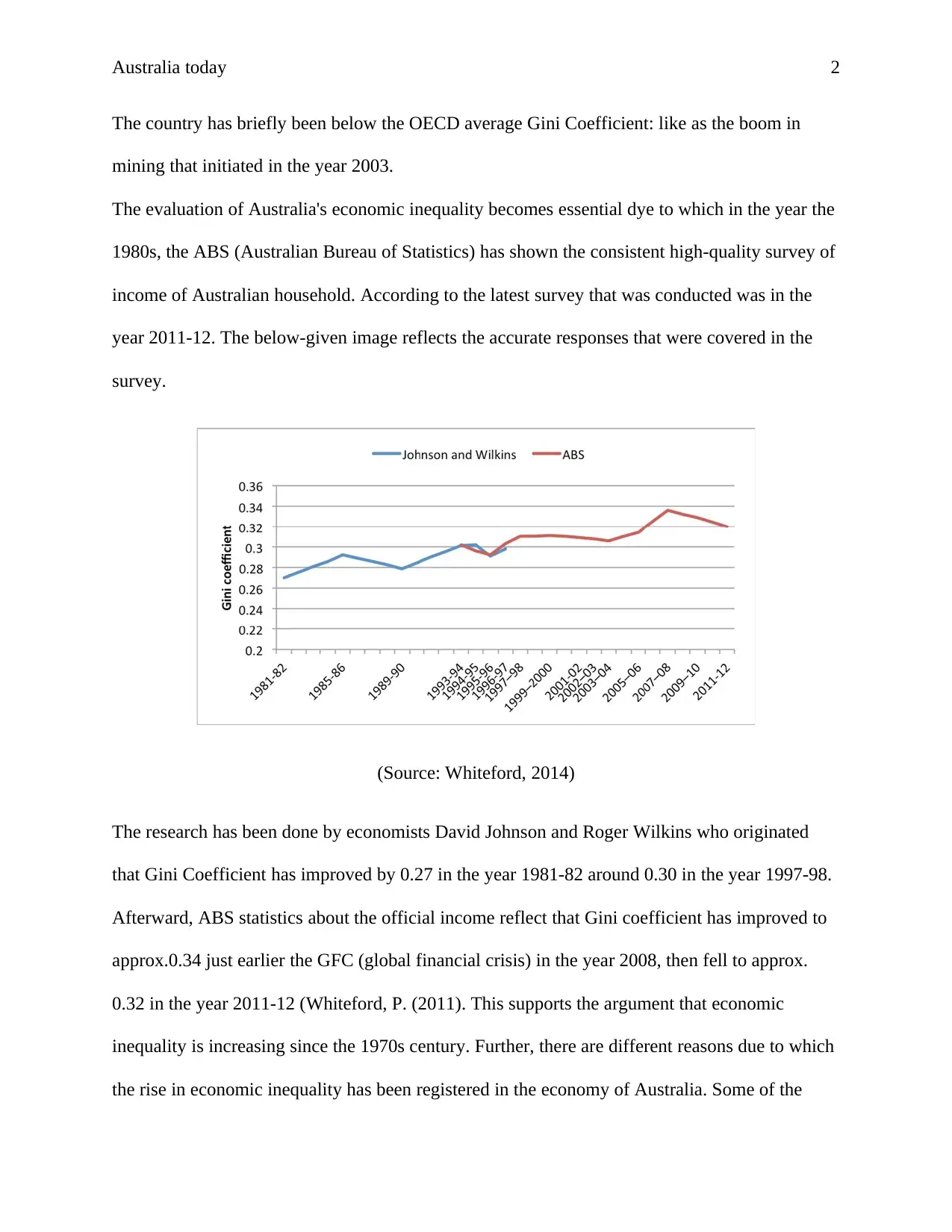
Australia today 2
The country has briefly been below the OECD average Gini Coefficient: like as the boom in
mining that initiated in the year 2003.
The evaluation of Australia's economic inequality becomes essential dye to which in the year the
1980s, the ABS (Australian Bureau of Statistics) has shown the consistent high-quality survey of
income of Australian household. According to the latest survey that was conducted was in the
year 2011-12. The below-given image reflects the accurate responses that were covered in the
survey.
(Source: Whiteford, 2014)
The research has been done by economists David Johnson and Roger Wilkins who originated
that Gini Coefficient has improved by 0.27 in the year 1981-82 around 0.30 in the year 1997-98.
Afterward, ABS statistics about the official income reflect that Gini coefficient has improved to
approx.0.34 just earlier the GFC (global financial crisis) in the year 2008, then fell to approx.
0.32 in the year 2011-12 (Whiteford, P. (2011). This supports the argument that economic
inequality is increasing since the 1970s century. Further, there are different reasons due to which
the rise in economic inequality has been registered in the economy of Australia. Some of the
The country has briefly been below the OECD average Gini Coefficient: like as the boom in
mining that initiated in the year 2003.
The evaluation of Australia's economic inequality becomes essential dye to which in the year the
1980s, the ABS (Australian Bureau of Statistics) has shown the consistent high-quality survey of
income of Australian household. According to the latest survey that was conducted was in the
year 2011-12. The below-given image reflects the accurate responses that were covered in the
survey.
(Source: Whiteford, 2014)
The research has been done by economists David Johnson and Roger Wilkins who originated
that Gini Coefficient has improved by 0.27 in the year 1981-82 around 0.30 in the year 1997-98.
Afterward, ABS statistics about the official income reflect that Gini coefficient has improved to
approx.0.34 just earlier the GFC (global financial crisis) in the year 2008, then fell to approx.
0.32 in the year 2011-12 (Whiteford, P. (2011). This supports the argument that economic
inequality is increasing since the 1970s century. Further, there are different reasons due to which
the rise in economic inequality has been registered in the economy of Australia. Some of the
⊘ This is a preview!⊘
Do you want full access?
Subscribe today to unlock all pages.

Trusted by 1+ million students worldwide
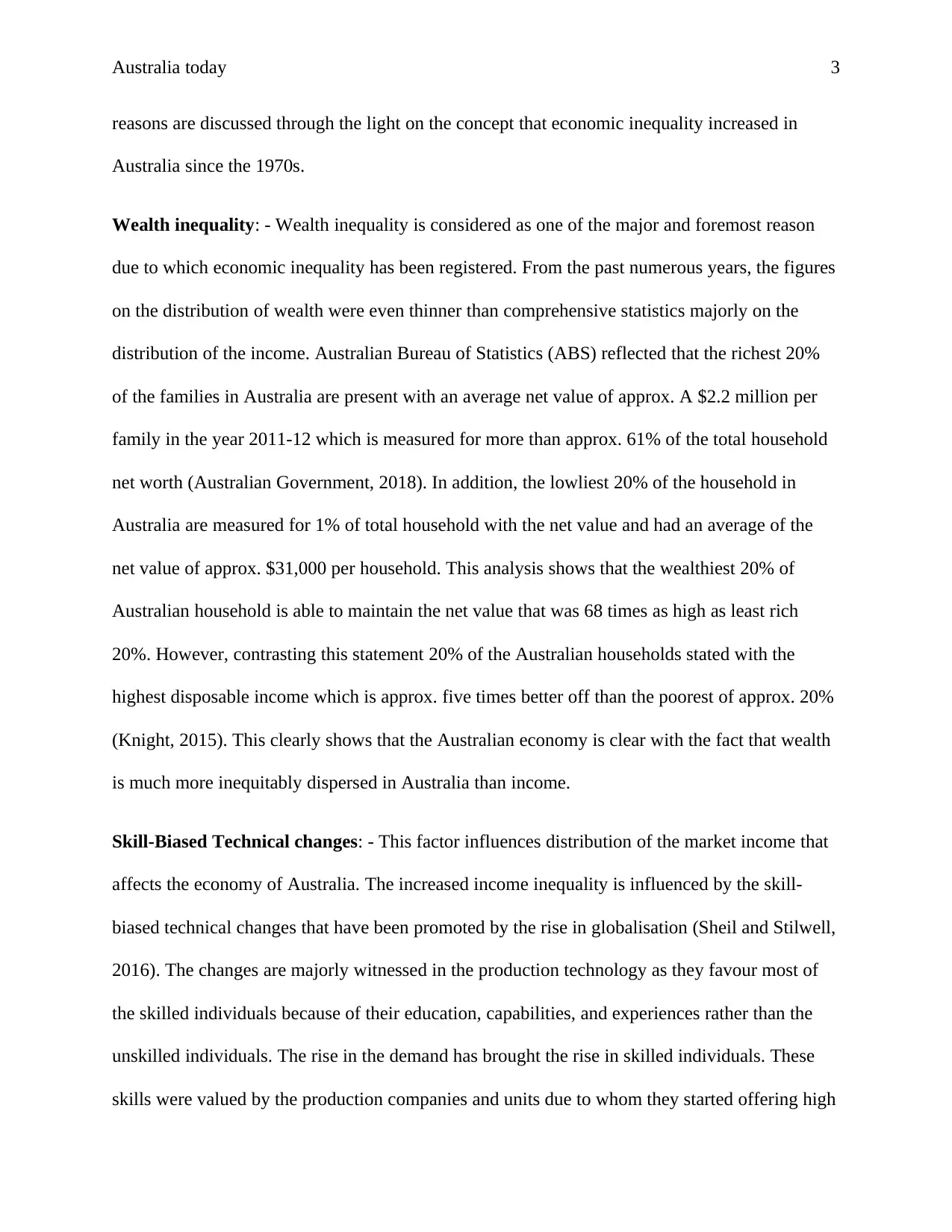
Australia today 3
reasons are discussed through the light on the concept that economic inequality increased in
Australia since the 1970s.
Wealth inequality: - Wealth inequality is considered as one of the major and foremost reason
due to which economic inequality has been registered. From the past numerous years, the figures
on the distribution of wealth were even thinner than comprehensive statistics majorly on the
distribution of the income. Australian Bureau of Statistics (ABS) reflected that the richest 20%
of the families in Australia are present with an average net value of approx. A $2.2 million per
family in the year 2011-12 which is measured for more than approx. 61% of the total household
net worth (Australian Government, 2018). In addition, the lowliest 20% of the household in
Australia are measured for 1% of total household with the net value and had an average of the
net value of approx. $31,000 per household. This analysis shows that the wealthiest 20% of
Australian household is able to maintain the net value that was 68 times as high as least rich
20%. However, contrasting this statement 20% of the Australian households stated with the
highest disposable income which is approx. five times better off than the poorest of approx. 20%
(Knight, 2015). This clearly shows that the Australian economy is clear with the fact that wealth
is much more inequitably dispersed in Australia than income.
Skill-Biased Technical changes: - This factor influences distribution of the market income that
affects the economy of Australia. The increased income inequality is influenced by the skill-
biased technical changes that have been promoted by the rise in globalisation (Sheil and Stilwell,
2016). The changes are majorly witnessed in the production technology as they favour most of
the skilled individuals because of their education, capabilities, and experiences rather than the
unskilled individuals. The rise in the demand has brought the rise in skilled individuals. These
skills were valued by the production companies and units due to whom they started offering high
reasons are discussed through the light on the concept that economic inequality increased in
Australia since the 1970s.
Wealth inequality: - Wealth inequality is considered as one of the major and foremost reason
due to which economic inequality has been registered. From the past numerous years, the figures
on the distribution of wealth were even thinner than comprehensive statistics majorly on the
distribution of the income. Australian Bureau of Statistics (ABS) reflected that the richest 20%
of the families in Australia are present with an average net value of approx. A $2.2 million per
family in the year 2011-12 which is measured for more than approx. 61% of the total household
net worth (Australian Government, 2018). In addition, the lowliest 20% of the household in
Australia are measured for 1% of total household with the net value and had an average of the
net value of approx. $31,000 per household. This analysis shows that the wealthiest 20% of
Australian household is able to maintain the net value that was 68 times as high as least rich
20%. However, contrasting this statement 20% of the Australian households stated with the
highest disposable income which is approx. five times better off than the poorest of approx. 20%
(Knight, 2015). This clearly shows that the Australian economy is clear with the fact that wealth
is much more inequitably dispersed in Australia than income.
Skill-Biased Technical changes: - This factor influences distribution of the market income that
affects the economy of Australia. The increased income inequality is influenced by the skill-
biased technical changes that have been promoted by the rise in globalisation (Sheil and Stilwell,
2016). The changes are majorly witnessed in the production technology as they favour most of
the skilled individuals because of their education, capabilities, and experiences rather than the
unskilled individuals. The rise in the demand has brought the rise in skilled individuals. These
skills were valued by the production companies and units due to whom they started offering high
Paraphrase This Document
Need a fresh take? Get an instant paraphrase of this document with our AI Paraphraser
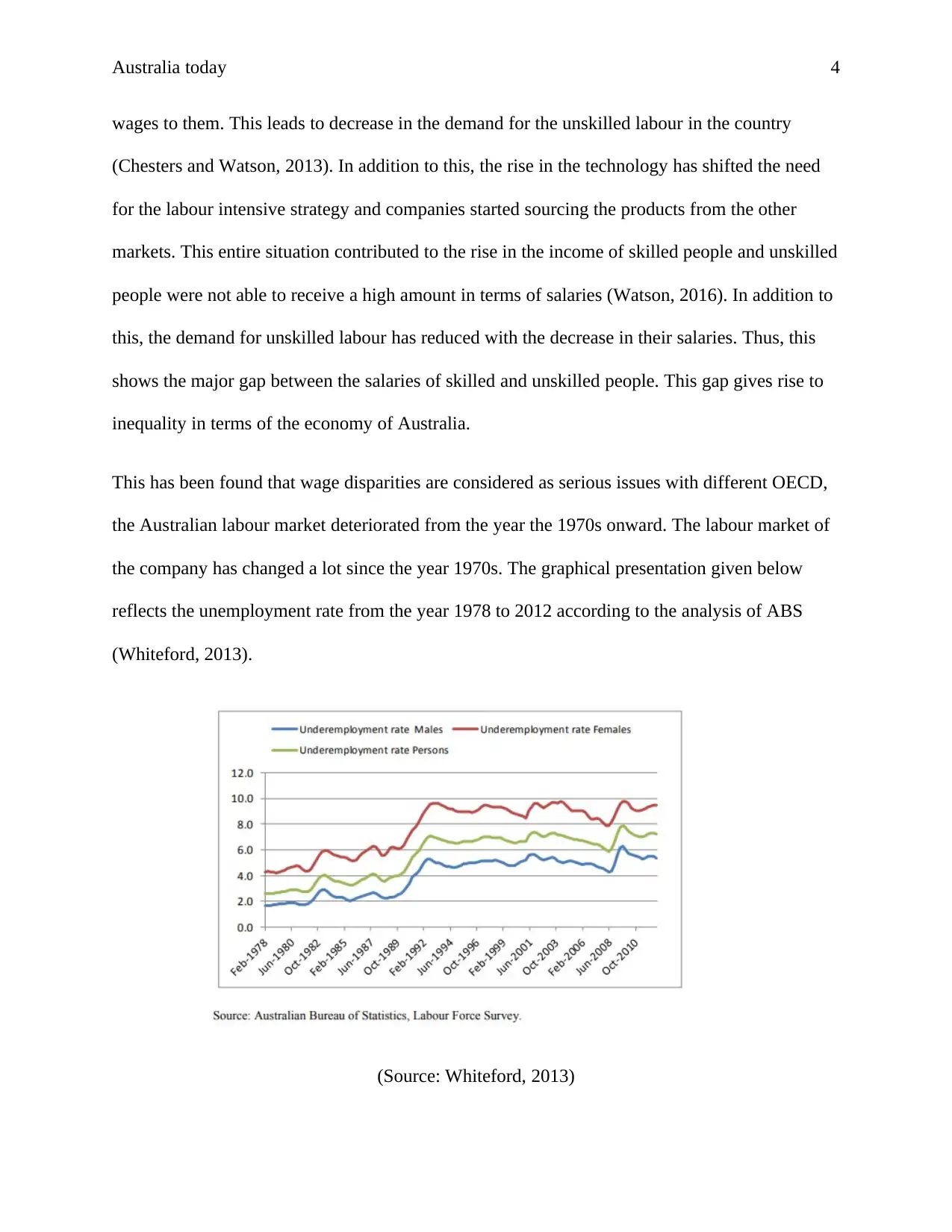
Australia today 4
wages to them. This leads to decrease in the demand for the unskilled labour in the country
(Chesters and Watson, 2013). In addition to this, the rise in the technology has shifted the need
for the labour intensive strategy and companies started sourcing the products from the other
markets. This entire situation contributed to the rise in the income of skilled people and unskilled
people were not able to receive a high amount in terms of salaries (Watson, 2016). In addition to
this, the demand for unskilled labour has reduced with the decrease in their salaries. Thus, this
shows the major gap between the salaries of skilled and unskilled people. This gap gives rise to
inequality in terms of the economy of Australia.
This has been found that wage disparities are considered as serious issues with different OECD,
the Australian labour market deteriorated from the year the 1970s onward. The labour market of
the company has changed a lot since the year 1970s. The graphical presentation given below
reflects the unemployment rate from the year 1978 to 2012 according to the analysis of ABS
(Whiteford, 2013).
(Source: Whiteford, 2013)
wages to them. This leads to decrease in the demand for the unskilled labour in the country
(Chesters and Watson, 2013). In addition to this, the rise in the technology has shifted the need
for the labour intensive strategy and companies started sourcing the products from the other
markets. This entire situation contributed to the rise in the income of skilled people and unskilled
people were not able to receive a high amount in terms of salaries (Watson, 2016). In addition to
this, the demand for unskilled labour has reduced with the decrease in their salaries. Thus, this
shows the major gap between the salaries of skilled and unskilled people. This gap gives rise to
inequality in terms of the economy of Australia.
This has been found that wage disparities are considered as serious issues with different OECD,
the Australian labour market deteriorated from the year the 1970s onward. The labour market of
the company has changed a lot since the year 1970s. The graphical presentation given below
reflects the unemployment rate from the year 1978 to 2012 according to the analysis of ABS
(Whiteford, 2013).
(Source: Whiteford, 2013)

Australia today 5
This has been found that since the year 1970 to the year 1990s rise in the unemployment
opportunities were clearly observed in the Australian economy that was the negative sign as this
will increase the gap between the inequalities present in the economy of Australia. In addition,
the Australian Bureau of statistics reflects that there is a tremendous rise in the unemployment
rate that shows that the country is not able to manage economic equality so far from the year
1970 (Coelli and Borland, 2016).
Tax and welfare regime: - In Australia, the level of income inequality has improved which has
ultimately brought the rise in the difference in the incomes of market. The changes in tax and
welfare regimes have increased effect that has been experienced in the present market outcomes.
The high in tax rates and increased in the level of generosity majorly on employment and social
assistance has significantly brought the rise in the inequality among the market between the year
1979 and 2004. This has been found that in the year the 1990s that the inequality in the market
inequality increased which shows that the tax and welfare programs were failed in decreasing the
polarization effect (Atkinson, 2015). The analysis shows that the lowering or reducing the
personal taxes generally for the higher incomes lead to the major issues of the unemployment
benefits. This is further supported by the issues of the rising in the inequality in Australia. The
researcher has an argument on the fact that tax is considered as the major contributor as if the
taxation on the income of the Australian has been frozen than the rich people will become richer
and poor will get poorest. Thus, this clearly states the economic inequality that is present in the
economy of Australia.
Economic crisis: - The economic crises, which took place in the year 1974-75 actively,
contributed to the inequality in Australia. At the end of the crisis, the trade unions of Australia
demanded the new wage structures for them that were quite high even more than the agreed rate.
This has been found that since the year 1970 to the year 1990s rise in the unemployment
opportunities were clearly observed in the Australian economy that was the negative sign as this
will increase the gap between the inequalities present in the economy of Australia. In addition,
the Australian Bureau of statistics reflects that there is a tremendous rise in the unemployment
rate that shows that the country is not able to manage economic equality so far from the year
1970 (Coelli and Borland, 2016).
Tax and welfare regime: - In Australia, the level of income inequality has improved which has
ultimately brought the rise in the difference in the incomes of market. The changes in tax and
welfare regimes have increased effect that has been experienced in the present market outcomes.
The high in tax rates and increased in the level of generosity majorly on employment and social
assistance has significantly brought the rise in the inequality among the market between the year
1979 and 2004. This has been found that in the year the 1990s that the inequality in the market
inequality increased which shows that the tax and welfare programs were failed in decreasing the
polarization effect (Atkinson, 2015). The analysis shows that the lowering or reducing the
personal taxes generally for the higher incomes lead to the major issues of the unemployment
benefits. This is further supported by the issues of the rising in the inequality in Australia. The
researcher has an argument on the fact that tax is considered as the major contributor as if the
taxation on the income of the Australian has been frozen than the rich people will become richer
and poor will get poorest. Thus, this clearly states the economic inequality that is present in the
economy of Australia.
Economic crisis: - The economic crises, which took place in the year 1974-75 actively,
contributed to the inequality in Australia. At the end of the crisis, the trade unions of Australia
demanded the new wage structures for them that were quite high even more than the agreed rate.
⊘ This is a preview!⊘
Do you want full access?
Subscribe today to unlock all pages.

Trusted by 1+ million students worldwide
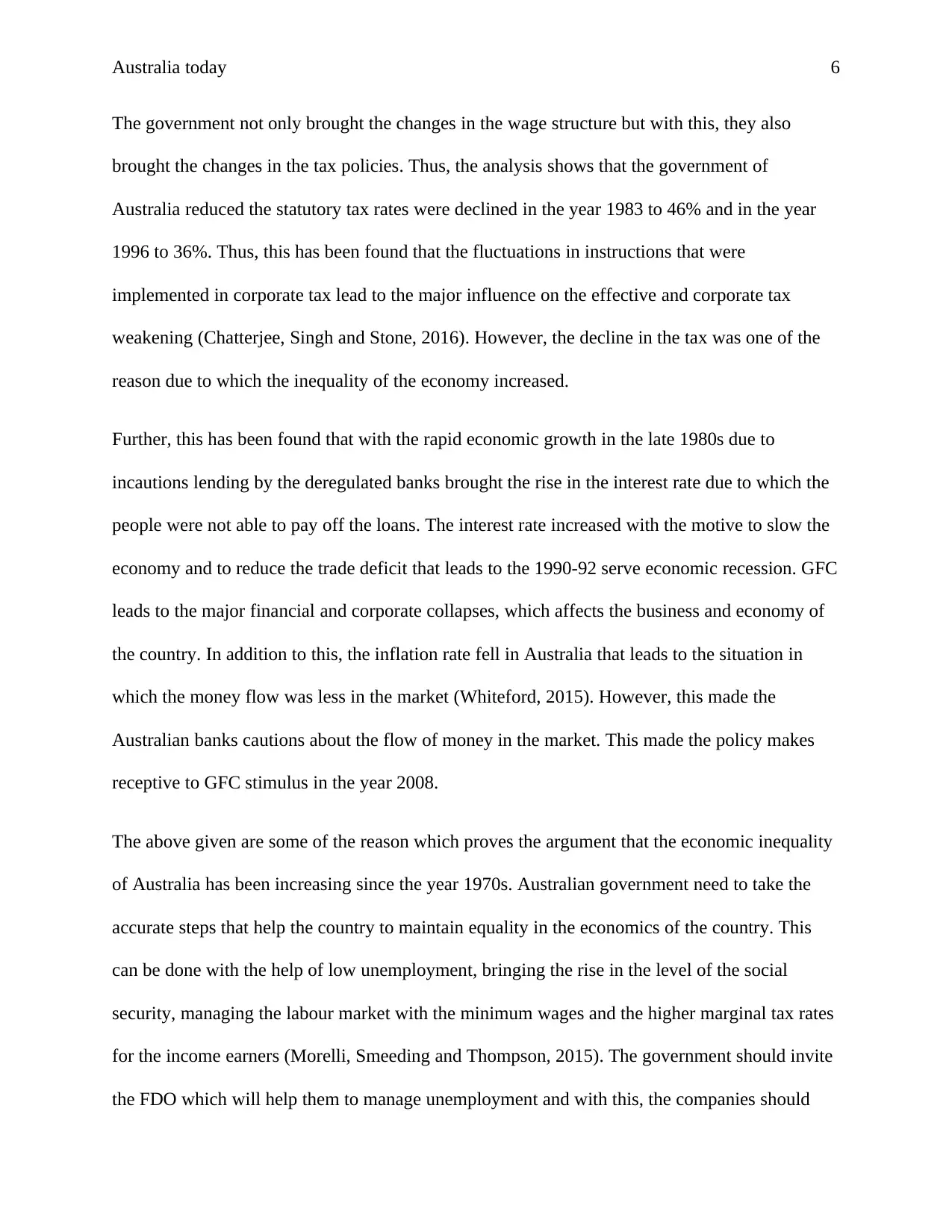
Australia today 6
The government not only brought the changes in the wage structure but with this, they also
brought the changes in the tax policies. Thus, the analysis shows that the government of
Australia reduced the statutory tax rates were declined in the year 1983 to 46% and in the year
1996 to 36%. Thus, this has been found that the fluctuations in instructions that were
implemented in corporate tax lead to the major influence on the effective and corporate tax
weakening (Chatterjee, Singh and Stone, 2016). However, the decline in the tax was one of the
reason due to which the inequality of the economy increased.
Further, this has been found that with the rapid economic growth in the late 1980s due to
incautions lending by the deregulated banks brought the rise in the interest rate due to which the
people were not able to pay off the loans. The interest rate increased with the motive to slow the
economy and to reduce the trade deficit that leads to the 1990-92 serve economic recession. GFC
leads to the major financial and corporate collapses, which affects the business and economy of
the country. In addition to this, the inflation rate fell in Australia that leads to the situation in
which the money flow was less in the market (Whiteford, 2015). However, this made the
Australian banks cautions about the flow of money in the market. This made the policy makes
receptive to GFC stimulus in the year 2008.
The above given are some of the reason which proves the argument that the economic inequality
of Australia has been increasing since the year 1970s. Australian government need to take the
accurate steps that help the country to maintain equality in the economics of the country. This
can be done with the help of low unemployment, bringing the rise in the level of the social
security, managing the labour market with the minimum wages and the higher marginal tax rates
for the income earners (Morelli, Smeeding and Thompson, 2015). The government should invite
the FDO which will help them to manage unemployment and with this, the companies should
The government not only brought the changes in the wage structure but with this, they also
brought the changes in the tax policies. Thus, the analysis shows that the government of
Australia reduced the statutory tax rates were declined in the year 1983 to 46% and in the year
1996 to 36%. Thus, this has been found that the fluctuations in instructions that were
implemented in corporate tax lead to the major influence on the effective and corporate tax
weakening (Chatterjee, Singh and Stone, 2016). However, the decline in the tax was one of the
reason due to which the inequality of the economy increased.
Further, this has been found that with the rapid economic growth in the late 1980s due to
incautions lending by the deregulated banks brought the rise in the interest rate due to which the
people were not able to pay off the loans. The interest rate increased with the motive to slow the
economy and to reduce the trade deficit that leads to the 1990-92 serve economic recession. GFC
leads to the major financial and corporate collapses, which affects the business and economy of
the country. In addition to this, the inflation rate fell in Australia that leads to the situation in
which the money flow was less in the market (Whiteford, 2015). However, this made the
Australian banks cautions about the flow of money in the market. This made the policy makes
receptive to GFC stimulus in the year 2008.
The above given are some of the reason which proves the argument that the economic inequality
of Australia has been increasing since the year 1970s. Australian government need to take the
accurate steps that help the country to maintain equality in the economics of the country. This
can be done with the help of low unemployment, bringing the rise in the level of the social
security, managing the labour market with the minimum wages and the higher marginal tax rates
for the income earners (Morelli, Smeeding and Thompson, 2015). The government should invite
the FDO which will help them to manage unemployment and with this, the companies should
Paraphrase This Document
Need a fresh take? Get an instant paraphrase of this document with our AI Paraphraser

Australia today 7
give importance to the home employees first rather than the foreign employees. Thus, this will
help the country in managing the unemployment rate with the labour market. Along with this, the
labour market will help in managing the wages that will further contribute in managing the taxes
that will manage the inequality of Australia economy.
At the end of the essay, this can be said that society or the economy of the country never remains
the same and equal all the time that it can be a horizon for disadvantages and they are difficult to
increase. The standard actions of economy might take residence high economic power with
motive to hand off the corporate owner majorly when it originates to the relation of employees.
The government of Australia is supposed to take some substitute and simplify the positive and
profitable actions of the corporate that majorly targets the defence of corporate property owner
from the injurious activities of employee's. The above discussion includes the major factors that
have subsidized to the growth in the economic dissimilarity in Australia after year 1970. These
factors include wealth inequality, skill-biased technical changes, tax and welfare regime and
economic crisis. The deep analysis of these factors shows that the government is still facing
inequality in the economy.
give importance to the home employees first rather than the foreign employees. Thus, this will
help the country in managing the unemployment rate with the labour market. Along with this, the
labour market will help in managing the wages that will further contribute in managing the taxes
that will manage the inequality of Australia economy.
At the end of the essay, this can be said that society or the economy of the country never remains
the same and equal all the time that it can be a horizon for disadvantages and they are difficult to
increase. The standard actions of economy might take residence high economic power with
motive to hand off the corporate owner majorly when it originates to the relation of employees.
The government of Australia is supposed to take some substitute and simplify the positive and
profitable actions of the corporate that majorly targets the defence of corporate property owner
from the injurious activities of employee's. The above discussion includes the major factors that
have subsidized to the growth in the economic dissimilarity in Australia after year 1970. These
factors include wealth inequality, skill-biased technical changes, tax and welfare regime and
economic crisis. The deep analysis of these factors shows that the government is still facing
inequality in the economy.

Australia today 8
References
Atkinson, A.B., 2015. Inequality. UK: Harvard University Press.
Australian Government (2018) Rising inequality? [Online]. Available from:
https://www.pc.gov.au/research/completed/rising-inequality/rising-inequality-highlights
Chatterjee, A., Singh, A. and Stone, T., 2016. Understanding wage inequality in
Australia. Economic Record, 92(298), pp.348-360.
Chesters, J. and Watson, L., 2013. Understanding the persistence of inequality in higher
education: Evidence from Australia. Journal of Education Policy, 28(2), pp.198-215.
Coelli, M. and Borland, J., 2016. Job polarisation and earnings inequality in Australia. Economic
Record, 92(296), pp.1-27.
Knight, G. (2015) FactCheck Q&A: is Australia the most unequal it has been in 75 years?
[Online]. Available from: https://theconversation.com/factcheck-qanda-is-australia-the-most-
unequal-it-has-been-in-75-years-47931
Morelli, S., Smeeding, T. and Thompson, J., 2015. Post-1970 trends in within-country inequality
and poverty: rich and middle-income countries. In Handbook of income distribution(Vol. 2, pp.
593-696). Elsevier.
Sheil, C. and Stilwell, F. (2016) The land of the 'fair go' no more: Wealth in Australia becoming
more unequal [Online]. Available from: https://www.abc.net.au/news/2016-08-09/australia-is-
land-of-the-fair-go-no-more/7703818
References
Atkinson, A.B., 2015. Inequality. UK: Harvard University Press.
Australian Government (2018) Rising inequality? [Online]. Available from:
https://www.pc.gov.au/research/completed/rising-inequality/rising-inequality-highlights
Chatterjee, A., Singh, A. and Stone, T., 2016. Understanding wage inequality in
Australia. Economic Record, 92(298), pp.348-360.
Chesters, J. and Watson, L., 2013. Understanding the persistence of inequality in higher
education: Evidence from Australia. Journal of Education Policy, 28(2), pp.198-215.
Coelli, M. and Borland, J., 2016. Job polarisation and earnings inequality in Australia. Economic
Record, 92(296), pp.1-27.
Knight, G. (2015) FactCheck Q&A: is Australia the most unequal it has been in 75 years?
[Online]. Available from: https://theconversation.com/factcheck-qanda-is-australia-the-most-
unequal-it-has-been-in-75-years-47931
Morelli, S., Smeeding, T. and Thompson, J., 2015. Post-1970 trends in within-country inequality
and poverty: rich and middle-income countries. In Handbook of income distribution(Vol. 2, pp.
593-696). Elsevier.
Sheil, C. and Stilwell, F. (2016) The land of the 'fair go' no more: Wealth in Australia becoming
more unequal [Online]. Available from: https://www.abc.net.au/news/2016-08-09/australia-is-
land-of-the-fair-go-no-more/7703818
⊘ This is a preview!⊘
Do you want full access?
Subscribe today to unlock all pages.

Trusted by 1+ million students worldwide
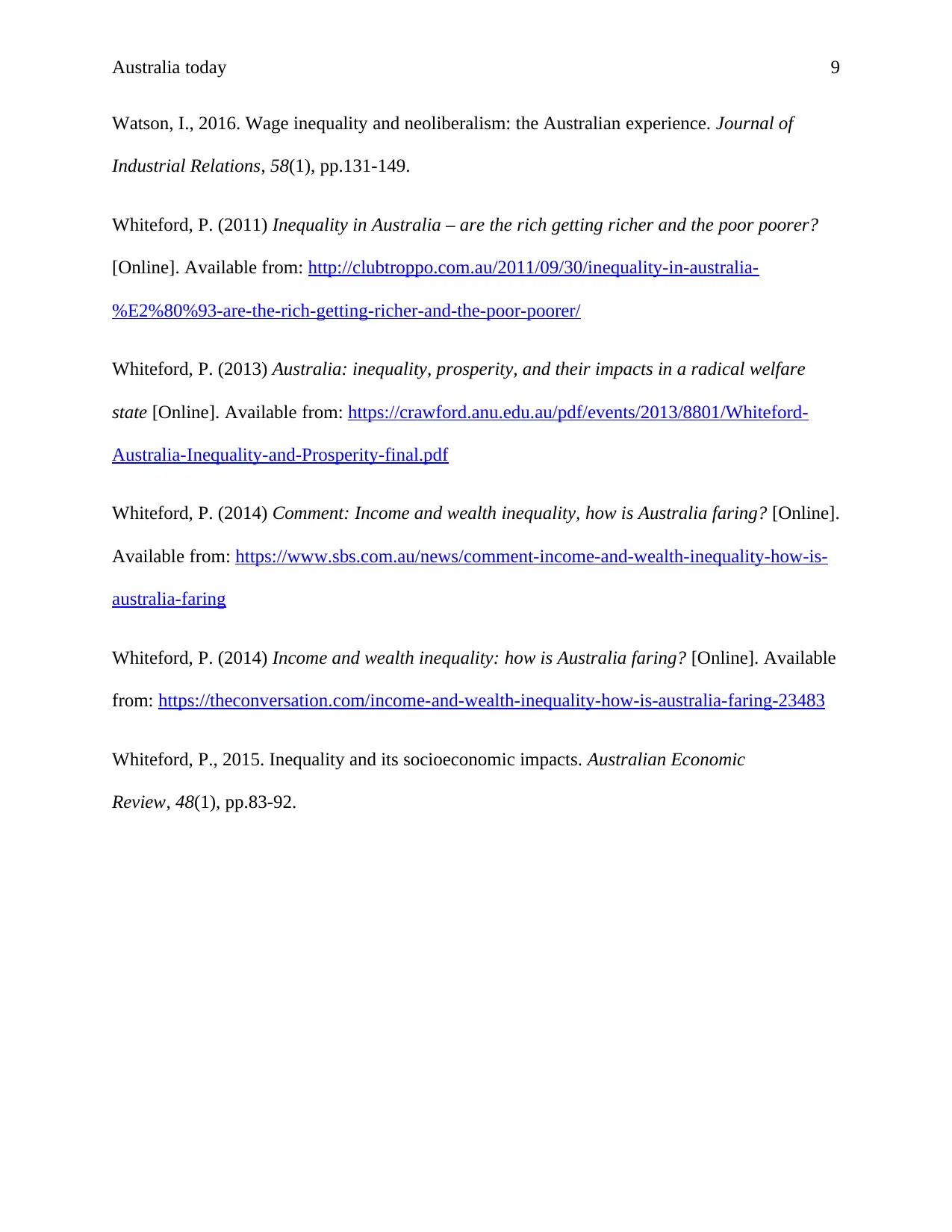
Australia today 9
Watson, I., 2016. Wage inequality and neoliberalism: the Australian experience. Journal of
Industrial Relations, 58(1), pp.131-149.
Whiteford, P. (2011) Inequality in Australia – are the rich getting richer and the poor poorer?
[Online]. Available from: http://clubtroppo.com.au/2011/09/30/inequality-in-australia-
%E2%80%93-are-the-rich-getting-richer-and-the-poor-poorer/
Whiteford, P. (2013) Australia: inequality, prosperity, and their impacts in a radical welfare
state [Online]. Available from: https://crawford.anu.edu.au/pdf/events/2013/8801/Whiteford-
Australia-Inequality-and-Prosperity-final.pdf
Whiteford, P. (2014) Comment: Income and wealth inequality, how is Australia faring? [Online].
Available from: https://www.sbs.com.au/news/comment-income-and-wealth-inequality-how-is-
australia-faring
Whiteford, P. (2014) Income and wealth inequality: how is Australia faring? [Online]. Available
from: https://theconversation.com/income-and-wealth-inequality-how-is-australia-faring-23483
Whiteford, P., 2015. Inequality and its socioeconomic impacts. Australian Economic
Review, 48(1), pp.83-92.
Watson, I., 2016. Wage inequality and neoliberalism: the Australian experience. Journal of
Industrial Relations, 58(1), pp.131-149.
Whiteford, P. (2011) Inequality in Australia – are the rich getting richer and the poor poorer?
[Online]. Available from: http://clubtroppo.com.au/2011/09/30/inequality-in-australia-
%E2%80%93-are-the-rich-getting-richer-and-the-poor-poorer/
Whiteford, P. (2013) Australia: inequality, prosperity, and their impacts in a radical welfare
state [Online]. Available from: https://crawford.anu.edu.au/pdf/events/2013/8801/Whiteford-
Australia-Inequality-and-Prosperity-final.pdf
Whiteford, P. (2014) Comment: Income and wealth inequality, how is Australia faring? [Online].
Available from: https://www.sbs.com.au/news/comment-income-and-wealth-inequality-how-is-
australia-faring
Whiteford, P. (2014) Income and wealth inequality: how is Australia faring? [Online]. Available
from: https://theconversation.com/income-and-wealth-inequality-how-is-australia-faring-23483
Whiteford, P., 2015. Inequality and its socioeconomic impacts. Australian Economic
Review, 48(1), pp.83-92.
1 out of 10
Related Documents
Your All-in-One AI-Powered Toolkit for Academic Success.
+13062052269
info@desklib.com
Available 24*7 on WhatsApp / Email
![[object Object]](/_next/static/media/star-bottom.7253800d.svg)
Unlock your academic potential
Copyright © 2020–2025 A2Z Services. All Rights Reserved. Developed and managed by ZUCOL.




